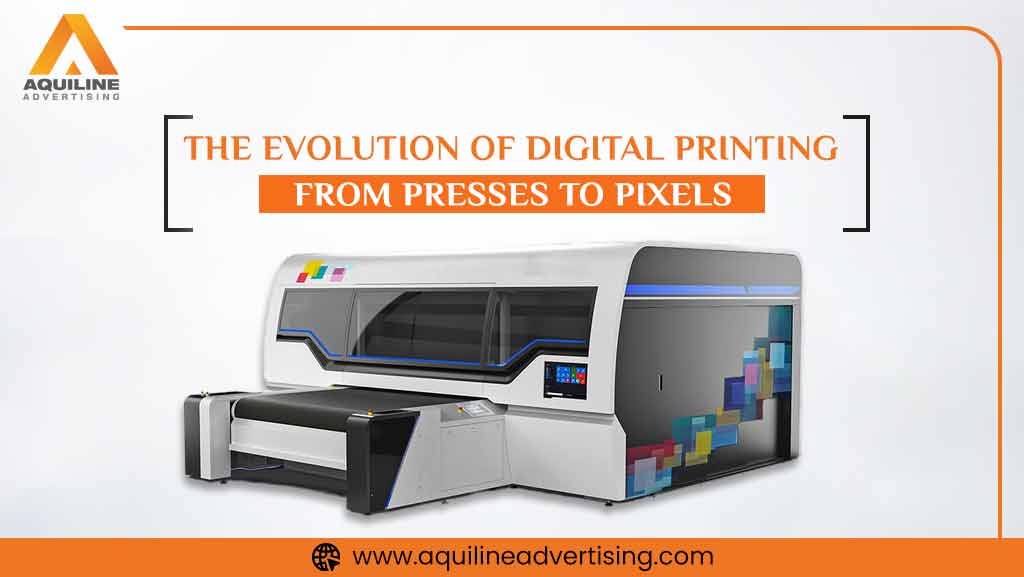May 27, 2024

In the vast landscape of printing technology, the evolution of digital printing stands as a
testament to human ingenuity and innovation. From the early days of mechanical presses to
the era of high-resolution digital printers, the journey of digital printing has been nothing
short of remarkable. In this blog, we’ll explore the fascinating evolution of digital printing,
tracing its origins, milestones, and the transformative impact it has had on various industries,
including the vibrant printing industry in Dubai and Abu Dhabi.
Origins of Digital Printing
The roots of digital printing can be traced back to the invention of the printing press by
Johannes Gutenberg in the 15th century. For centuries, traditional printing methods like
letterpress and offset printing dominated the industry, relying on mechanical processes to
transfer ink onto paper. While these methods revolutionized mass communication and
publishing, they were limited in terms of flexibility, speed, and cost-effectiveness.
The dawn of the digital age in the late 20th century paved the way for a new era of printing
technology. It began with the development of early digital printing technologies such as laser
printers and inkjet printers, which used electronic data to produce printed output. These
technologies laid the foundation for the emergence of modern digital printing techniques,
offering increased speed, efficiency, and versatility compared to traditional methods.
Milestones in Digital Printing
1. Desktop Publishing Revolution: The introduction of desktop publishing software in
the 1980s empowered individuals and small businesses to create and print
documents with unprecedented ease and flexibility. Coupled with the rise of laser
printers and inkjet printers, desktop publishing democratized access to printing
technology, revolutionizing the publishing industry.
2. Digital Presses and Variable Data Printing: The development of digital presses in
the late 20th century marked a significant milestone in the evolution of digital printing.
Unlike traditional offset presses, digital presses enabled on-demand printing and
variable data printing, allowing for personalized and customized printed materials
with minimal setup time and cost.
3. Wide Format Printing: The advent of wide format digital printers expanded the
possibilities of digital printing beyond traditional paper-based materials. Wide format
printers are capable of printing on a variety of substrates, including vinyl, fabric, and
rigid materials, making them ideal for signage, banners, vehicle wraps, and other
large-format applications.
4. 3D Printing Revolution: While not strictly a form of traditional printing, 3D printing
represents a revolutionary advancement in digital fabrication technology. 3D printers
use additive manufacturing techniques to create three-dimensional objects layer by
layer, offering unprecedented flexibility and customization in product design and
manufacturing.
Transformative Impact on Industries
1.Publishing and Printing: Digital printing has transformed the publishing and printing
industries, enabling on-demand printing, short print runs, and personalized content.
Publishers and printers can now produce books, magazines, and marketing materials
more efficiently and cost-effectively, catering to the demands of niche markets and
individual consumers.
2. Advertising and Marketing: Digital printing has revolutionized advertising and
marketing, allowing brands to create highly targeted and personalized campaigns.
Variable data printing enables marketers to customize printed materials with
individualized messages, images, and offers, resulting in higher engagement and
conversion rates.
3. Packaging and Labeling: The packaging industry has embraced digital printing for
its ability to produce high-quality, short-run packaging and labeling materials. Digital
printing offers brands greater flexibility in design, faster time-to-market, and reduced
waste compared to traditional printing methods, making it ideal for product packaging
and labeling applications.
4. Fashion and Textiles: Digital printing has also made significant inroads in the
fashion and textiles industry, enabling designers to create custom fabrics and
garments with intricate patterns and vibrant colors. Digital textile printing offers
unparalleled flexibility and precision, allowing designers to bring their creative visions
to life on fabric with stunning results.
Future Directions
As technology continues to advance, the future of digital printing holds even greater promise
and potential. Emerging technologies such as 3D printing, nanotechnology, and augmented
reality are poised to further revolutionize the printing industry, opening up new possibilities
for customization, sustainability, and innovation.
In Conclusion,
the evolution of digital printing from presses to pixels has reshaped the way
we create, communicate, and consume printed materials. From the Gutenberg press to
modern digital printers, printing technology has undergone a remarkable transformation,
driven by a relentless pursuit of efficiency, quality, and creativity. As we look to the future, the
possibilities of digital printing are limited only by our imagination, and in Dubai and Abu
Dhabi, where printing companies thrive, the impact of digital printing is particularly profound.